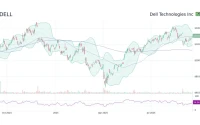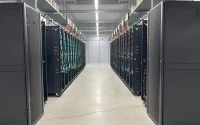The AI boom is loud. It’s a deafening roar of nine-figure funding rounds, exponential user growth, and stock charts that look like rocket launches. We’re inundated with narratives about god-like intelligence and world-changing applications. But underneath all that noise, there’s a quiet, persistent hum—the sound of millions of servers in sprawling data centers, all consuming a staggering amount of electricity. That hum is getting louder, and the heat it generates is becoming the single greatest physical constraint on the entire AI revolution.
For all the talk of algorithms and neural networks, the future of AI isn't just about software. It’s about thermodynamics. It’s a brutal, unforgiving equation of performance-per-watt. Companies like Nvidia, AMD, and Broadcom design the brilliant engines for this new economy, but they don’t actually build them. They are, in industry parlance, “fabless.” They all turn to one place to forge their silicon dreams into reality: a single, dominant, and strategically neutral company in Taiwan.
And that company, Taiwan Semiconductor Manufacturing (TSMC), is about to deliver a solution to the industry’s heat problem that the market still seems to be fundamentally misinterpreting.
The Physics of Profit
Let’s be precise. The headline event is that TSMC is on track to begin mass production of its 2-nanometer (2nm) chips in 2025. To the casual observer, this sounds like just another incremental step on the long road of Moore’s Law. It is not. The specifications reveal something far more critical: at the same speed, the 2nm process node is projected to consume 25% to 30% less power than the current 3nm generation.
This isn’t just a nice-to-have efficiency gain. For an AI company operating a data center, this is the equivalent of a miracle. Energy consumption isn't just an environmental footnote on a corporate responsibility report; it's a primary driver of operational expenditure and a hard cap on computational density. You can only pack so many processors into a building before you can no longer cool it effectively or afford the utility bill. Imagine the hum of the servers in a vast, windowless data center, the air thick with the smell of warm electronics. That physical reality—the heat—is the enemy. A 25% reduction in power draw is a direct, massive assault on that enemy.
This makes TSMC’s role in the AI ecosystem something entirely different from its clients. Nvidia and AMD are in a brutal, competitive race for architectural supremacy. They are the celebrity race car drivers. But TSMC is the one company that’s repaving the entire racetrack with a surface that lets every car perform better. It’s a foundational improvement that lifts all boats. TSMC isn’t betting on a single AI champion; it is, quite simply, the house.
So, why does the market reward the individual drivers so much more than the owner of the track itself? What explains the persistent valuation gap between TSMC and the very clients who are wholly dependent on its manufacturing prowess?

A Fundamental Mispricing
An analyst at The Motley Fool recently made the case in an article titled Semiconductor Sales Could Keep Soaring in 2026: 1 Top Stock to Buy Hand Over Fist Before That Happens, anticipating the growth that 2nm will unlock. This isn’t a fringe opinion, but it highlights a discrepancy that has bothered me for some time. When you look at the numbers, TSMC consistently trades at a significant valuation discount to its premier clients. The market assigns a massive premium to the architectural blueprints but a discount to the company that owns the only factory on Earth capable of building the skyscraper.
This is where the standard narrative breaks down. We're told that the value is in the intellectual property of the chip design. But what is the value of a brilliant design that cannot be manufactured at scale? The most advanced chips are a duopoly at best, and for the cutting-edge nodes (like the upcoming 2nm process), TSMC is effectively a monopoly. They have a technological lead that competitors have spent tens of billions of dollars failing to close.
I’ve looked at hundreds of these filings and valuation models, and this particular schism in the semiconductor space is unusual. The market is essentially saying that the risk lies with the manufacturer, not the designer. Does this make any logical sense? TSMC is diversified across the entire industry, serving Apple, Nvidia, AMD, and Broadcom. It wins no matter which company’s design proves superior in a given year. The fabless designers, meanwhile, live and die by the success of their next product cycle. The risk profile seems inverted.
The market appears to be betting on one of two things: either a competitor like Samsung or Intel will suddenly, miraculously, close a technology gap that has been widening for a decade, or the premium for chip design IP will expand into perpetuity. The first bet seems improbable. The second ignores the law of gravity. As the AI hardware buildout accelerates—with some deals now topping $100 billion—the focus will inevitably shift from design wins to the core constraints of power and supply. Who can deliver the most performance-per-watt, and who can deliver it at a scale of millions of units? The answer to both questions is TSMC.
The Pick-and-Shovel Play is Being Ignored
Here’s the unvarnished truth: the market is captivated by a story. It’s a great story, full of genius designers and visionary CEOs. But it’s a story that overlooks the less glamorous, but far more critical, foundation upon which it is built. Investing in fabless chip designers is a bet on a specific brand of genius. Investing in their sole-source manufacturer is a bet on the simple, in-progress, and predictable continuation of physics.
The launch of the 2nm process in 2025 isn't just another product release. It's a catalyst. It represents a tangible, 25-30% relief on the single greatest bottleneck facing the entire AI industry. When the operational cost savings from that efficiency gain start hitting the quarterly earnings reports of data center operators, the flow of capital will follow. The narrative will be forced to confront the physical reality.
The discrepancy between the value of the blueprint and the value of the forge is a market inefficiency. And like all such inefficiencies, it won’t last forever. Physics always wins.









